Keep up with the latest hiring trends!

Hubspot, the marketing specialists, recently released a list of the 107 Mind-Blowing Sales Statistics That Will Help You Sell Smarter. Being the curious folks that we are, we decided to take a look through and see how many of these stats can and should be applied to recruiters to help them sell their jobs to candidates better. After all, candidates are our customers and essentially what we do every day is sell to them. This is what we discovered:
1. 44% of salespeople give up after one follow up, yet 80% of sales requires 5 follow ups.
In other words, the fact that a candidate hasn’t responded to your initial reach out email, DOES NOT mean they are not interested. They may have been busy when they received the email first, or they may have simply forgotten to reply. Silence does not mean no. Only no means no. Therefore, it’s exceptionally important for you to follow up on each and every one of your candidate emails. You’ve likely spent a lot of time searching for the candidate you have contacted by email, so it makes complete sense to rule them in or out before you re-start your search from scratch.
Start using a free email tracking tool like Sidekick, which will tell you (in real time) when a candidate has opened your email. If they see it but don’t respond within 24 hours, be sure to follow up. After 24 hours, the likelihood of a response falls from 90% to just 3%. However, Yesware has proven that by continuing to send more emails, you create more opportunities for your recipient to reply:
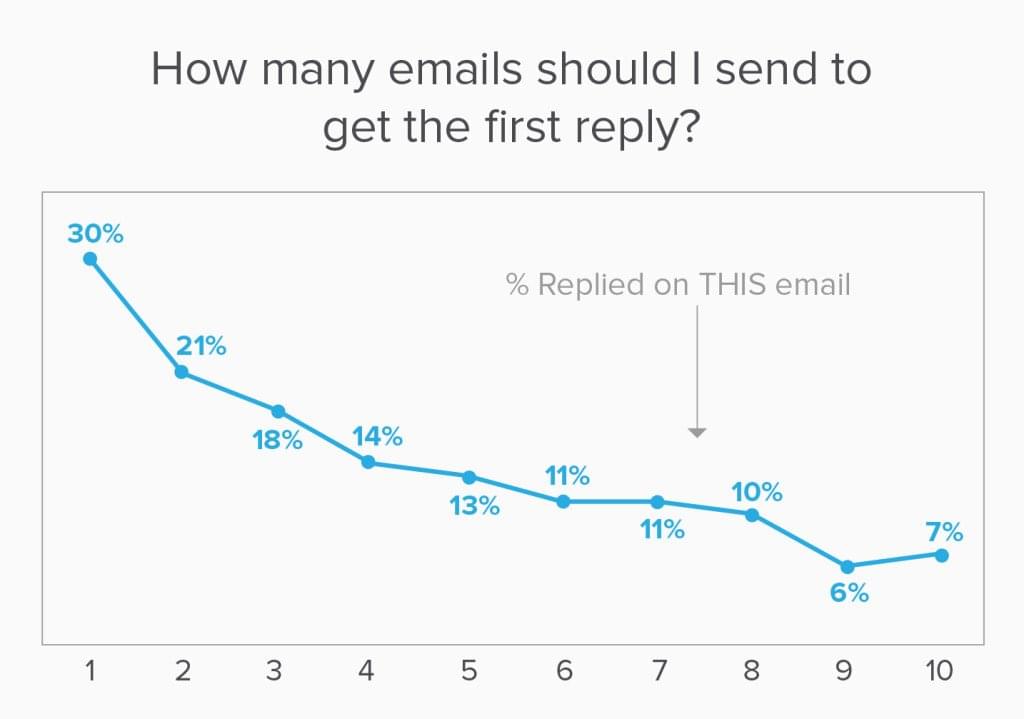
Source: Yesware
2. 63% of people requesting information of your company today will not purchase for at least 3 months (and 20% will take more than 12 months to buy).
Like customers making a purchase decision, candidates need time to become familiar with your company before they will make a decision on whether or not they’d like to work for you. As recruiters, we very often tend to launch straight in with our job ads and tell them to “apply now!”. We forget that it takes people a long time before they get to that “purchase stage” of actually sending an application, and that even after they apply we still need to nurture them to get them over the line and actually sign a contract.
Our blog ‘How to: Successfully Influence Candidates at EVERY Stage of their Decision-Making Process‘, highlights each of the 4 stages associated with the candidate “consideration loop” (i.e. the decision-making process), and the specific employer branding efforts you can use to influence your candidates throughout each of these stages. Read it to gain an insight into the mind of your candidate at each stage and how you can nurture them.
3. After a presentation, 63% of attendees remember stories. Only 5% remember statistics.
If you were a candidate looking for a job in recruitment and you read the following two statements in two different job ads, which job would you be more likely to apply to?
- Job ad #1: “You will have responsibility for the identification and hire of 15 new staff.”
- Job ad #2: “We started last year with 6 people. Stephen and Reza then joined us as interns after responding to a Youtube video; no salary, just the will to grow and learn. Lisa trained as a Black Belt 3 years ago in her old job. She called asking us if we were hiring and we snapped her up. Since then we’ve hired Johnny’s brother Graham and his mate Dave. This year, your job will be to scale this to 15 more people. You’ve got your work cut out! ;)”
Both job ads tell us exactly the same thing, but job ad #2 has given us so much more insight into the company looking to hire. We now know the story of how they’ve gotten to where they are now. We feel invested in the people mentioned in this story. We’d love to meet them. And we’re relishing the challenge of putting our skills to the test to find more people like Stephen, Reza, Lisa, Graham and Dave, and adding to this already great team.
As the incredible Chip and Dan Heath said in their book ‘Made to Stick‘, “Credible ideas make people believe. An emotional idea makes people care. The right stories make people act.” And as recruiters, that’s exactly what we need them to do, act! We need to compel the right people to apply for our jobs. And the best way to do that is through storytelling in your job ads. Storytelling grabs attention in a crowded marketplace and makes you memorable.
4. 95% of buyers chose a solutions provider that provided them with ample content to help navigate through each stage of the buying process.
In a recent survey by Software Advice, a company that compares recruiting tools, 59% of jobseekers said that unclear application instructions “significantly worsen” their candidate experience, while 35% said it “somewhat worsened” their experience. That means that in total, a whopping 94% of candidates regard clear application instructions as a must have when applying to an organisation. That’s why having an FAQs section on your careers site is exceptionally important.
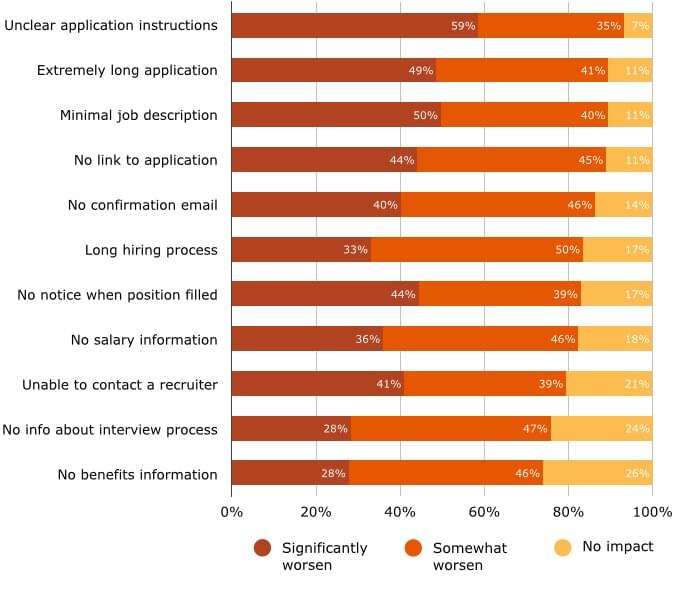
Having an FAQs section on your careers site that informs candidates as to what they should expect from your application process and your interview process, sets their expectations. If you prepare people and tell them what they can expect from your application process in advance, they won’t be in for any nasty shocks. Their expectations will have been set and as long as you then meet those expectations, you have made the application process a pleasant one for them.
If your ATS asks them 10 pages of questions and normally takes 40 minutes to fill out, tell them they will be asked 10 pages of questions and they will need 40 minutes in which to answer them. If you usually conduct a phone interview before a face-to-face interview, tell them. For a great example of how a real-life company has put this into practice, check out Glanbia’s Graduate Recruitment Process as detailed on their graduate programme website.
5. The best time to email prospects are 8am and 3pm. Tuesday emails have the highest open rate compared with any other weekday and personalised emails increase click through rates by 14%.
While it is universally agreed that Tuesday is the best day to send emails, the consensus on time is a little harder to pin down. While Hubspot cite 8am and 3pm as the best times, CoSchedule have research to prove that late-morning send times (10am and 11am) are the most successful and that the second best time is between 8pm and midnight.
In general, the best time to send emails will always come down to the person/audience you are sending the email to, so when deciding on the best time to send an email to your chosen candidate, be mindful of that person’s most likely schedule.
6. In 2007, it took an average 3.68 cold call attempts to reach a prospect. In 2016, it takes 8!
People are busy. And no one is (or should be) more busy than in-demand candidates. They’re hard to reach by phone which is why most recruiters resort back to InMail or email to try and get in contact with them. But the results from the Global Recruiting Survey 2016 found that phone is hands-down the most effective way of contacting candidates, with a 44% response rate in comparison to a 35% response rate on LinkedIn.
So, while it can be difficult to reach candidates by phone, it is well worth the extra time and effort involved. For some advice on how to go about using the phone to recruit, check out our guide entitled ‘The 10 Golden Rules for Using the Phone to Contact Candidates‘.
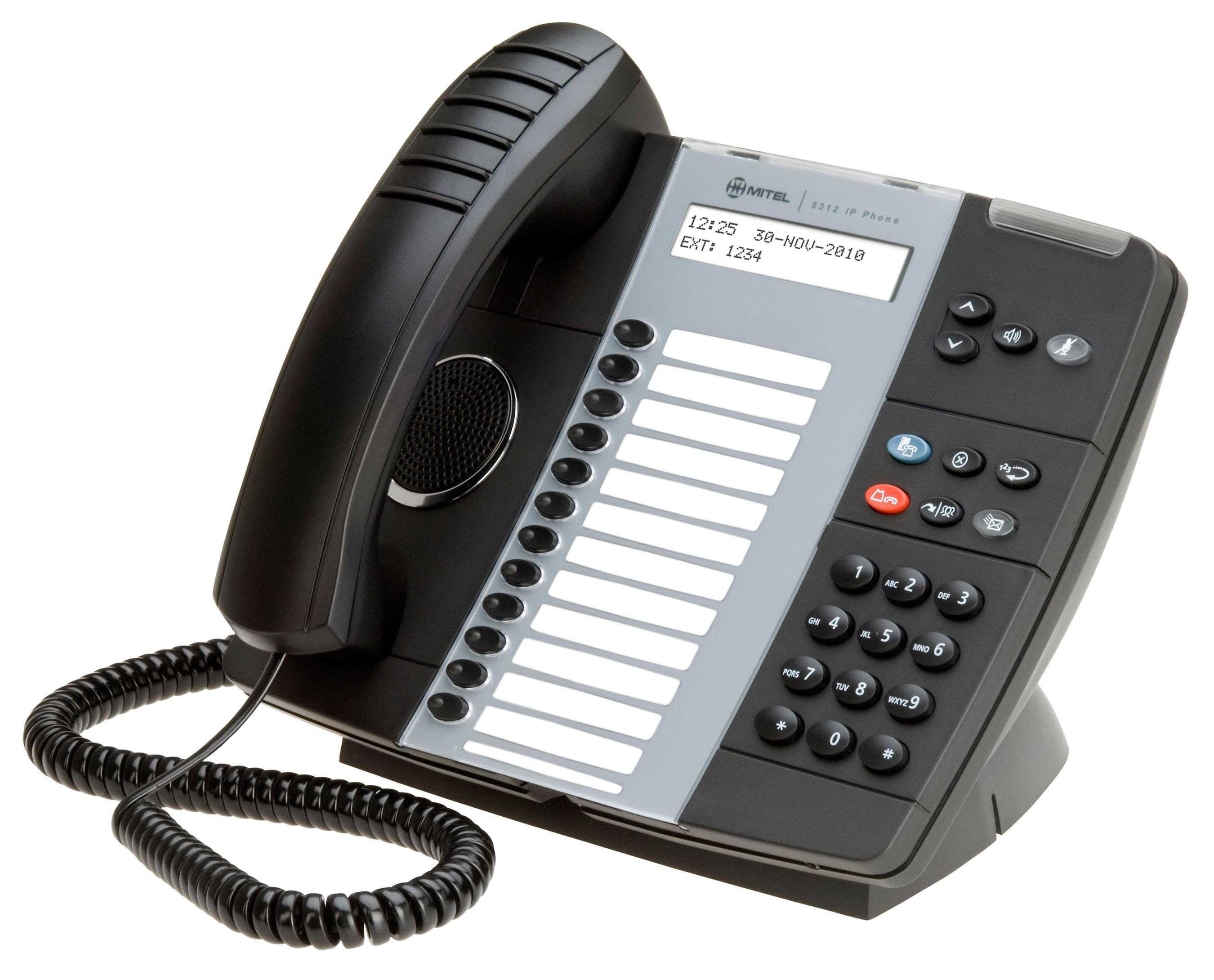
7. On the phone, tone is 86% of our communication. The words we use are only 14% of our communication.
When trying to reach your candidate via phone, chances are, the first person that you’ll speak to is going to be a receptionist. And chances are that when you ask if ‘Joe Bloggs’ is available, they’ll ask who you are and what the call is in reference to. But don’t fret. Obviously, you’re not going to say ‘It’s Mary here, just wanted to speak to Joe about a possible job opportunity’, how are you?
The key here is to be in control of the conversation. So when you ask if Joe is free and the receptionist asks what it’s in reference to, give your name and say that you sent information over to him and wanted to chat about it, but follow that up immediately with another question like ‘Is Joe usually at his desk around this time?’ Keep asking questions and remember to ask them confidently. You have to retain control during the exchange so that the Gatekeeper is the one that has to do all of the answering. If they advise you that Joe isn’t available, ask ‘When would be a good time for me to call back?’ or ‘Is it better to call his direct line?’
8. The best time to cold call is 4-5pm. The second best time is between 8 and 10am. The worst times to cold call are 11am and 2pm.
Between 4-5pm, people are starting to wind down for the day. At that point they will have most of their tasks completed for the day and (hopefully) most meetings finished with too. The Gatekeeper will also be winding down for the day and may be more amenable to helping you out and putting you through to the candidate.
Between 8 and 10am, most people won’t have really gotten into the swing of the day yet, so they may be more willing to accept phone calls. At 11am and 2pm, people are busy and are more likely to be in a meeting or in the middle of a task. This is definitely not a good time to start trying to tell them about a new job!
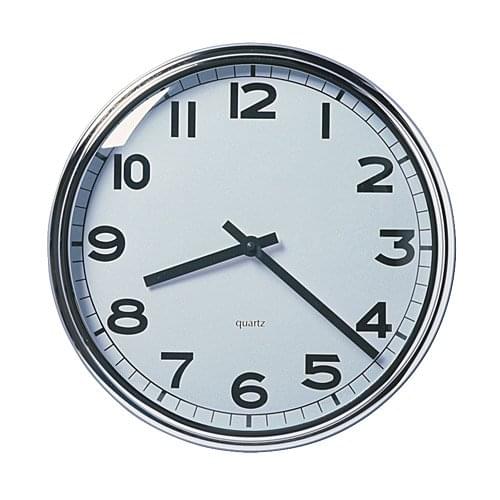
9. You are 70% more likely to get an appointment on an unexpected sale if you join LinkedIn Groups.
What are large and active LinkedIn Groups full of? That’s right folks, potential candidates! LinkedIn Groups are massive jobseeker pools filled with like-minded prospects you can interact with in a group setting. By joining groups, you can efficiently broaden your scope of applicants, and ultimately find a great fit for the job in question. Unsure how the whole Groups thing works? Don’t worry we have a complete guide on how to use the new LinkedIn Groups feature.
10. 50% of sales time is wasted on unproductive prospecting.
While conducting the 2016 Global Recruiting Survey, we found that the average LinkedIn response rate of a recruiter in 2016 is about 28%. But just because a candidate responds to you on LinkedIn, doesn’t mean they’ll necessarily say yes to the opportunity you’re offering. Some will decline to go any further in the process. So, we asked recruiters, “what percentage of candidates who do respond to you on LinkedIn, agree to go forward in the process”? 27% was the average response.
We delved even further by asking, “what percentage of candidates you submit to the hiring manager are called for interview”? On average, our respondents told us that two-thirds (66%) of the candidates they send forward actually get an interview. But that begs the question, how many candidates does the hiring manager want to have on their interview panel from which to make a hiring decision? The average we got back was 4. That means that the average recruiter’s funnel in 2016 looks like this:
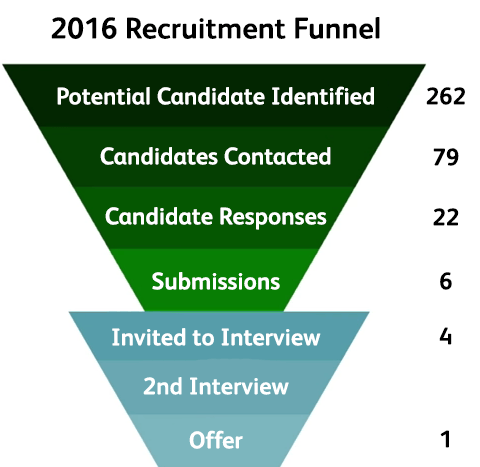
In order to make 1 hire, you told us the hiring manager needs to interview 4 people. But if just 66% of the candidates you send forward to the hiring manager are selected for interview, to get 4 on the interview panel you have to submit 6 people to the hiring manager. But if just 27% of the candidates you reach out agree to go forward in the process, to submit 6 people to the hiring manager, you need to speak to 22 people. To get 22 people talking to you, how many people do you have to reach out to? Well, if your average response rate on LinkedIn is 28%, to get 22 people talking you need to reach out to 79 people. But if you’re only reaching out to 28% of your LinkedIn search results, that means you need to identify a whopping 262 people in a search!
So, to make one hire, you need to identify 282 per open vacancy… Does that look like an efficient funnel to you?! Just look at the waste! This funnel shows us that 72% of our search results are not relevant, which means that we view and discard circa 200 profiles per assignment. Quite significant when you consider we send between 30-60 seconds viewing each profile! It also shows us that 72% of the candidates we contact never respond, meaning we just spammed 60 people. And if 73% of the candidates who do respond to us say no, we just had 16 wasted conversations. This is an EXTREMELY wasteful process! And one that can be avoided if you know how to plan and structure your searches properly.
Not connected with us on social? Stay in touch and keep up-to-date with all the latest recruitment news, research highlights and our wide range of useful resources.
Related Articles
Find out how the likes of IBM, IKEA and Siemens
drive hiring excellence with SocialTalent
drive hiring excellence with SocialTalent

